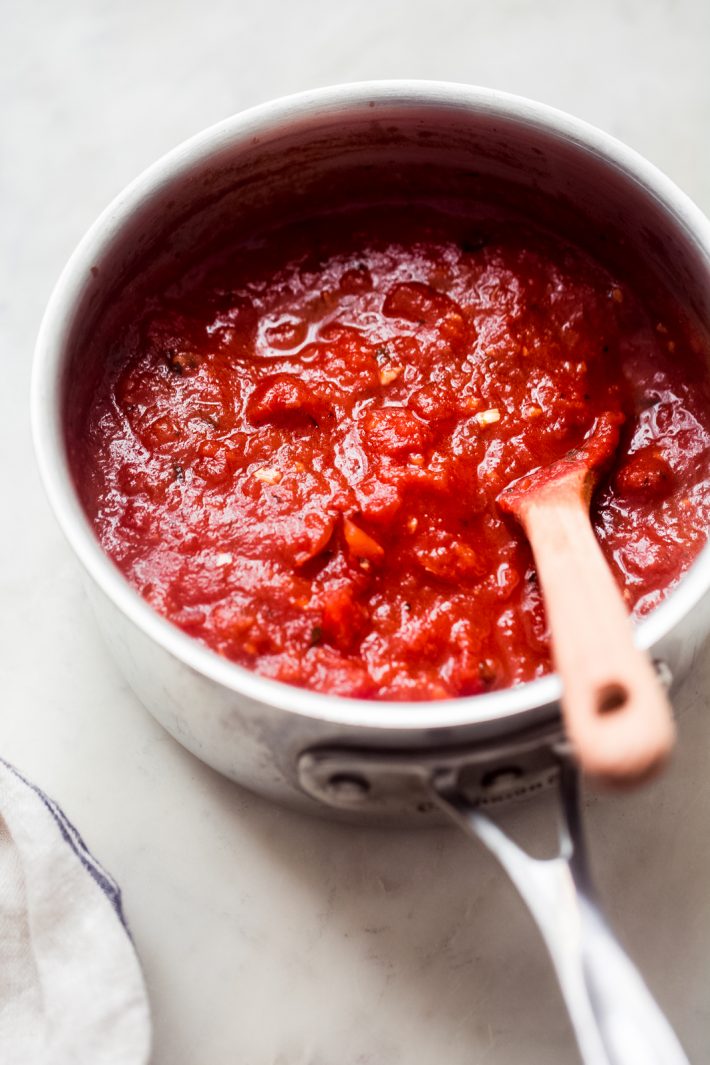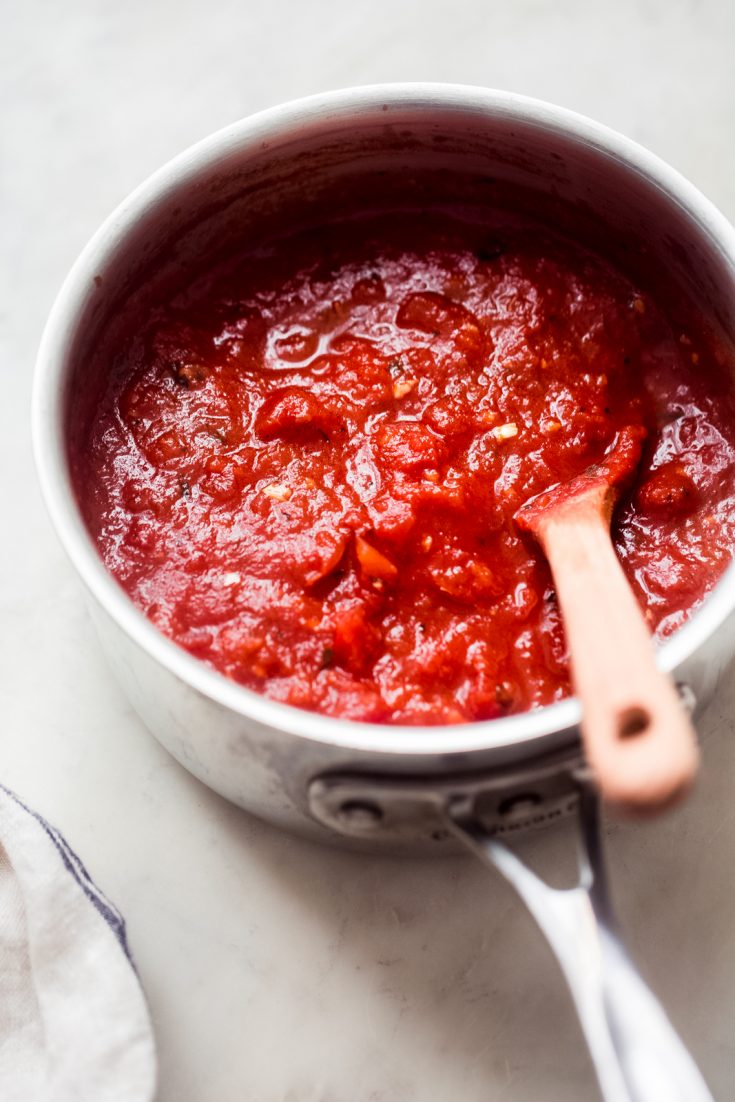How to Make Pizza Sauce: The Ultimate Recipe Guide
To make pizza sauce, combine crushed tomatoes, garlic, olive oil, and herbs, and simmer. Adjust seasoning with salt, sugar, and pepper for taste.
Creating a splendid pizza sauce is a straightforward process that infuses your homemade pizza with authentic Italian flair. This simple but flavorful concoction is the foundation of any great pizza, complementing the toppings and melted cheese. Crafted from quality crushed tomatoes, the ideal pizza sauce melds the rich tanginess of the tomatoes with a blend of savory garlic, a drizzle of olive oil, and a carefully chosen mix of herbs like oregano, basil, and a hint of thyme.
Each ingredient plays a pivotal role, contributing to a harmonious balance of flavors. A pinch of salt, a dash of sugar, and a twist of freshly ground black pepper accentuate the taste profile. This homemade pizza sauce promises to elevate your pizza from good to gourmet with minimum effort and maximum taste satisfaction.
The Essence Of A Good Pizza Sauce
The Essence of a Good Pizza Sauce lies not just in its ingredients, but in the nostalgia it carries. A good sauce transports you to a tiny pizzeria in Italy with the first bite. It’s the foundation of any pizza, holding all the toppings in a symphony of flavors. Mastering the sauce is crucial. It’s what makes or breaks your pizza experience.
Key Ingredients For Flavor
The right blend of ingredients elevates a simple sauce to extraordinary. Focus on freshness and quality:
- Ripe tomatoes: the core of the sauce, bursting with natural sweetness and tartness.
- Fresh herbs: basil and oregano add a classic Italian aroma and depth.
- Garlic and onions: for that pungent kick that complements the tomatoes.
- Extra virgin olive oil: adds richness and carries flavors together.
- Seasonings: salt, pepper, and a touch of sugar balance the acidity.
Texture And Consistency Considerations
The ideal pizza sauce clings to your toppings without sogging the dough:
- Simmer tomatoes slowly to reduce excess water.
- Crush or blend to your desired texture – smooth or chunky.
- Test consistency by coating a spoon; it should hold a trail.
Always let your sauce cool before spreading on the pizza base to prevent a soggy crust.

Credit: littlespicejar.com
Sourcing Ingredients For Authenticity
Creating the perfect pizza sauce is akin to an artist choosing their paints. The palette of flavors hinges on the authenticity and quality of the ingredients used. Embarking on a culinary journey to craft an unforgettable pizza sauce starts with the key step of sourcing the very best components. This authenticity ensures that every scoop of sauce will bring forth a taste of tradition and craftsmanship straight from Italy’s heart to your kitchen.
Choosing The Right Tomatoes
Tomatoes are the soul of pizza sauce. Select sun-ripened, plum tomatoes ideally grown in the volcanic soils of San Marzano near Naples for a truly authentic flavor. Their balance of sweetness and acidity is unmatched, and their thick flesh makes for a richer, smoother sauce. For convenience, look for canned San Marzano tomatoes with a Protected Designation of Origin (PDO) label, signaling they’re the real deal.
Fresh Vs. Dried Herbs
The debate between fresh and dried herbs is ongoing, but each brings its unique strengths to pizza sauce. Fresh herbs, like basil and oregano, impart a vibrant, lively flavor and are ideal if used immediately. On the other hand, dried herbs offer more concentrated flavor and have a longer shelf life, making them suitable for sauces that will simmer for awhile or be stored. For the best of both worlds, consider using a combination to enhance the sauce’s complexity.
- Fresh Basil – Adds a peppery sweetness.
- Oregano – Introduces an earthy, slightly bitter taste.
- Thyme – Gives a subtle, sharp fragrance.
Remember, when using dried herbs, use about one-third the amount compared to fresh. This ensures the sauce doesn’t become overwhelmed by the concentrated flavor of the dried herbs.
Preparation Techniques
Mastering the art of pizza sauce is a game-changer for any homemade pizza enthusiast. Discovering the right preparation techniques can elevate your pizza sauce from good to unforgettable. Let’s dive into how to blend ingredients for optimal smoothness and explore various cooking methods.
Blending Ingredients For Smoothness
A smooth sauce is key to a great pizza experience. Start by selecting ripe, juicy tomatoes as they form the sauce base. Use a blender or food processor to achieve that silky texture. Peel and deseed your tomatoes to avoid any chunks. Add fresh herbs like basil and oregano for a flavor burst. Blend everything until smooth. Taste and adjust the seasoning as needed.
Cooking Methods Explored
Though some chefs swear by a raw sauce, others prefer to cook it down. To cook, pour the blend into a saucepan. Stir in salt, pepper, and a pinch of sugar to balance acidity. Simmer the sauce on low heat. This step concentrates the flavors. Let it cook for about 20 to 30 minutes. Remember to stir frequently to prevent burning. Once done, let it cool before spreading on your pizza dough.
| Ingredient | Preparation | Cooking |
|---|---|---|
| Tomatoes | Blend until smooth | Simmer 20-30 min |
| Herbs | Mix in blender | Include in simmer |
:max_bytes(150000):strip_icc()/guide-to-homemade-pizza-FT-MAG0322-5269d2b72b9b4d69aa3634c5d182b11b.jpg)
Credit: www.foodandwine.com
Secrets To Enhancing Flavor
The secret to a tantalizing pizza sauce lies in layering flavors. Crafting a sauce that dances across the taste buds requires more than just tomatoes and a pinch of salt. In the world of pizza connoisseurs, a sauce must have depth, character, and a perfect harmony of tastes. With a few simple tips, transform a good pizza sauce into a great one, ensuring each bite is an experience in itself.
Balancing Acidity And Sweetness
Finding the sweet spot between tangy and sweet can elevate your pizza sauce. Achieving this balance is key. Tomatoes naturally contain both acid and sugar, making them a dynamic base for any sauce. Below are the tips to fine-tune your sauce’s pH level:
- Add sugar judiciously – Start with a pinch and increase incrementally.
- Splash of sweetness – A bit of honey or carrot can subtly adjust sweetness levels.
- Cooking time matters – Simmer sauce to reduce tanginess as tomatoes mellow when cooked.
- Taste as you go – Keep tabs on the flavor balance as you add sweetness enhancers.
Infusing With Herbs And Spices
Herbs and spices are the magic makers in a sauce’s flavor profile. They introduce aromatic notes and complex undertones. Fresh or dried, the choice of herbs will steer the sauce’s essence.
| Herb/Spice | Description | Usage Tip |
|---|---|---|
| Basil | Aromatic, sweet | Add fresh towards the end of cooking. |
| Oregano | Earthy, bold | Sprinkle dried early in the simmering stage. |
| Garlic | Pungent, spicy | Crushed fresh cloves infuse more flavor. |
| Chili Flakes | Hot, penetrating | Use sparingly for a gentle kick. |
Combine herbs and spices effectively for a rich, multi-dimensional sauce. Remember:
- Layer flavors – Start with base spices then add delicate herbs.
- Respect the simmer – Allow time for flavors to marry and infuse.
- Experiment confidently – Small batch tests can lead to perfect blends.
Storing And Freezing Tips
Perfect pizza starts with the sauce. But what happens when you have leftover sauce? Storing and freezing correctly will save the day. Let’s dive into how you can keep your pizza sauce tasting garden-fresh. Follow these tips and enjoy a perfect slice every time!
Maintaining Freshness For Future Use
Proper storage of pizza sauce is vital for preserving its tangy freshness.
- Always use an airtight container to prevent contamination.
- Refrigerate sauce within two hours of cooking to preserve its flavor.
- Label the container with the date, so you know when to use it by.
Refrigerated sauce lasts for up to five days. Beyond that, it’s not as fresh.
Best Practices For Freezing And Thawing
Freezing is a great way to extend your sauce’s shelf life.
| Freezing | Thawing |
|---|---|
|
|
Store frozen sauce up to three months for peak flavor. Enjoy your homemade sauce any time!
Creative Variations And Uses
Embark on a flavor journey with our guide to creating pizza sauces that elevate your pies to new heights! Explore the realm of creative variations and discover unique uses that transform traditional recipes into gourmet creations. Let’s dive into the art of pizza sauce alchemy!
Adding A Modern Twist To Classics
Classic pizza sauce is timeless, yet adding a modern twist can make it unforgettable. Reinvent the wheel with these clever tweaks:
- Spice Infusion: Mix in smoked paprika or chili flakes for a fiery kick.
- Herbal Notes: Fresh basil or rosemary will add fragrance to your sauce.
- Creamy Delight: Blend in soft cheeses like ricotta for a creamy twist.
- Global Fusion: Integrate flavors such as curry or harissa for an international spin.
Beyond Pizza: Other Culinary Applications
Your homemade pizza sauce need not be confined to pizza alone. Examine these other culinary applications where pizza sauce becomes the star:
| Dish | How to Use Pizza Sauce |
|---|---|
| Stuffed Bell Peppers | Mix sauce with rice and ground meat, then bake. |
| Pasta | Use as a base for your favorite pasta dish. |
| Meatball Sub | Spread over meatballs in a hot sub sandwich. |
| Shakshuka | Add an Italian spin by using pizza sauce. |

Credit: littlespicejar.com
Can I Use Homemade Pizza Sauce with Different Toppings for the Best Flavor?
Yes, you can definitely use homemade pizza sauce with different toppings for the best flavor. One of the perfect pizza topping layering secrets is to start with the sauce, then add cheese, followed by your choice of toppings. This way, each layer adds to the overall taste experience of the pizza.
Frequently Asked Questions On How To Make Pizza Sauce
What Are Essential Pizza Sauce Ingredients?
The fundamental ingredients for pizza sauce are tomatoes, olive oil, garlic, oregano, basil, salt, and pepper. These create the traditional flavor loved worldwide.
How To Thicken Pizza Sauce Effectively?
To thicken pizza sauce, simmer it over low heat until it reaches your desired consistency. Another method is to add a small amount of tomato paste.
Can You Make Pizza Sauce Without Cooking?
Yes, you can make uncooked pizza sauce. Simply blend quality canned tomatoes, herbs, garlic, and olive oil together. The flavors meld as the sauce sits.
What’s The Difference Between Marinara And Pizza Sauce?
Marinara sauce is typically thinner and seasoned with a simpler spice profile, while pizza sauce is thicker, with a more robust blend of herbs and spices.
Conclusion
Crafting the perfect pizza sauce is an art that elevates your homemade pizza to new heights. With the simple steps covered, you’re now equipped to create a delicious base for your next culinary masterpiece. Remember, practice makes perfect, and tweaking the recipe to your taste is all part of the fun.
So grab your apron, fresh ingredients, and let the scent of Italy inspire your kitchen creations. Happy cooking and even happier pizza feasting!

